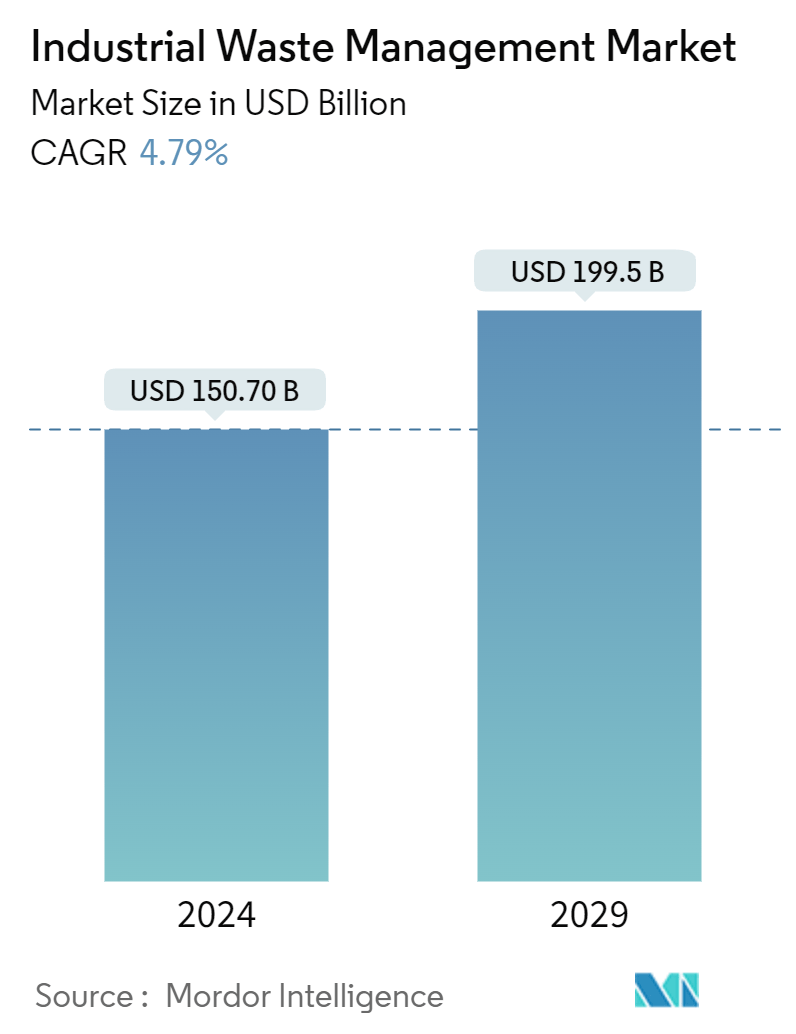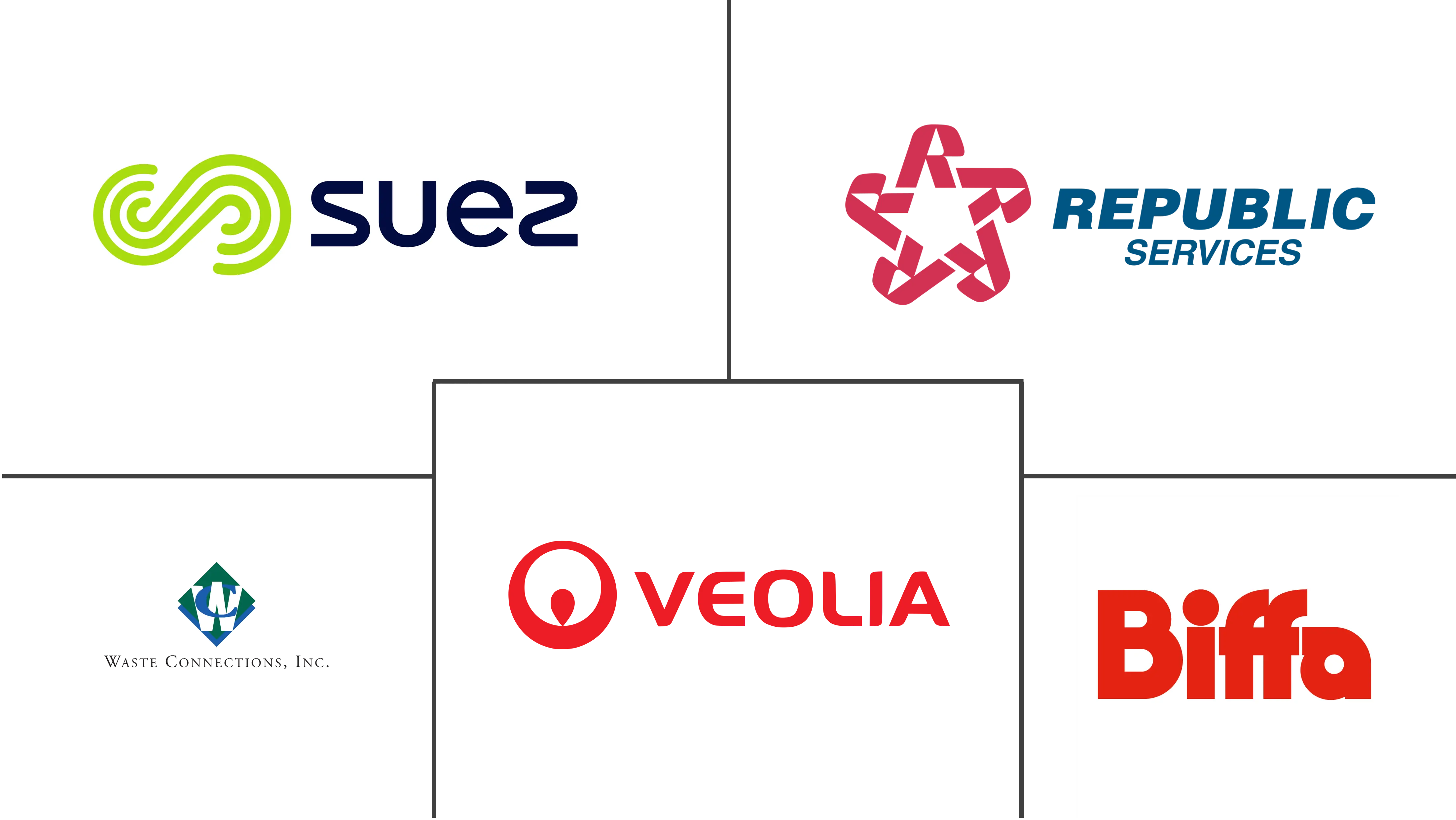Market Size of Industrial Waste Management Industry

| Study Period | 2020 - 2029 |
| Market Size (2024) | USD 150.70 Billion |
| Market Size (2029) | USD 199.5 Billion |
| CAGR (2024 - 2029) | 4.79 % |
| Fastest Growing Market | Asia Pacific |
| Largest Market | North America |
Major Players
*Disclaimer: Major Players sorted in no particular order |
Industrial Waste Management Market Analysis
The Industrial Waste Management Market size is estimated at USD 150.70 billion in 2024, and is expected to reach USD 199.5 billion by 2029, growing at a CAGR of 4.79% during the forecast period (2024-2029).
Waste management operations, data analysis, and machine learning are being applied increasingly in industries. Predictive analytics can forecast trends in the generation of waste streams to help municipalities and waste management companies allocate resources. Greyparrot is a trusted solution in the waste management market. By increasing translucency and automation in waste management, Greyparrot's AI waste analytics platform is at the forefront of circular economy development.
The proliferation of single-use plastics and nondegradable packaging materials is one of the major challenges in managing waste. Innovative packaging solutions are being developed to tackle this problem. Biodegradable and compostable materials are being developed to replace traditional plastics and reduce the environmental impact of packaging waste. In May 2023, Borealis introduced a mono-material pouch specifically designed for recycling that is said to represent more than 95% polypropylene. The pouch is intended to pack dry food products and aims to meet the eco-modulation criteria for extended producer responsibility (EPR) programs.
Robotic systems have a key role to play in streamlining the recycling process. These robots can identify and sort recyclable materials with remarkable accuracy and speed. Recycling facilities can increase the efficiency of their operations and reduce the contamination of recycled materials by automation of the sorting process. In April 2023, Il Solco, an Italian waste management company, partnered with Recycleye, intending to introduce artificial intelligence robotics in the waste management industry worldwide.
Industrial Waste Management Industry Segmentation
The systematic planning, collection, transport, treatment, disposal, and monitoring of waste generated by industrial activities are referred to as industrial waste management. This comprehensive process aims to reduce the environmental impact of industrial waste and comply with regulatory requirements. Industrial waste consists of different types of solid, liquid, and gaseous byproducts produced in manufacturing, processing, mining, or other industrial activities.
A complete background analysis of the industrial waste management market, including the assessment of the economy and contribution of sectors in the economy, market overview, market size estimation for key segments, and emerging trends in the market segments, market dynamics, and geographical trends, is covered in the report.
The industrial waste management market is segmented by disposal methods (landfill, incineration, and recycling), type (hazardous and non-hazardous), and geography (North America, Europe, Asia-Pacific, Middle East and Africa, and Latin America). The report offers market size and forecast in terms of value (USD) for all the above segments.
| By Disposal Methods | |
| Landfill | |
| Incineration | |
| Recycling |
| By Type | |
| Hazardous | |
| Non-hazardous |
| By Geography | |||||||
| |||||||
| |||||||
| |||||||
| Middle East and Africa | |||||||
| Latin America |
Industrial Waste Management Market Size Summary
The industrial waste management market is experiencing significant growth, driven by advancements in technology and increasing industrial activities, particularly in the Asia-Pacific region. The integration of data analysis, machine learning, and predictive analytics is enhancing the efficiency of waste management operations. Companies like Greyparrot are leading the way in incorporating AI-driven analytics to promote transparency and automation, supporting the development of a circular economy. The market is also witnessing innovations in packaging solutions, such as biodegradable materials and mono-material pouches, aimed at reducing the environmental impact of waste. Robotic systems are playing a crucial role in improving recycling processes by accurately identifying and sorting recyclable materials, thereby increasing operational efficiency and reducing contamination.
The market landscape is moderately fragmented, with major players like Veolia Environnement, SUEZ, and Waste Management leading the industry. These companies are forming strategic alliances with smaller firms to enhance their regional logistics capabilities and offer comprehensive waste management solutions. The adoption of smart waste management systems, utilizing IoT and wireless sensor technologies, is providing innovative solutions to urban waste management challenges. These systems offer economic and environmental benefits by optimizing waste collection and disposal processes. Recent developments, such as NEC Corporation's real-time waste monitoring system in Thailand and P&G's digital watermarking test in France, highlight the ongoing efforts to improve waste management practices globally.
Industrial Waste Management Market Size - Table of Contents
-
1. MARKET INSIGHTS
-
1.1 Current Market Scenario
-
1.2 Technological Trends
-
1.3 Industry Value Chain Analysis
-
1.4 Government Regulations and Initiatives
-
-
2. MARKET SEGMENTATION
-
2.1 By Disposal Methods
-
2.1.1 Landfill
-
2.1.2 Incineration
-
2.1.3 Recycling
-
-
2.2 By Type
-
2.2.1 Hazardous
-
2.2.2 Non-hazardous
-
-
2.3 By Geography
-
2.3.1 North America
-
2.3.1.1 United States
-
2.3.1.2 Canada
-
-
2.3.2 Europe
-
2.3.2.1 United Kingdom
-
2.3.2.2 Germany
-
2.3.2.3 France
-
2.3.2.4 Russia
-
2.3.2.5 Rest of Europe
-
-
2.3.3 Asia-Pacific
-
2.3.3.1 China
-
2.3.3.2 Japan
-
2.3.3.3 India
-
2.3.3.4 South Korea
-
2.3.3.5 Rest of Asia-Pacific
-
-
2.3.4 Middle East and Africa
-
2.3.5 Latin America
-
-
Industrial Waste Management Market Size FAQs
How big is the Industrial Waste Management Market?
The Industrial Waste Management Market size is expected to reach USD 150.70 billion in 2024 and grow at a CAGR of 4.79% to reach USD 199.5 billion by 2029.
What is the current Industrial Waste Management Market size?
In 2024, the Industrial Waste Management Market size is expected to reach USD 150.70 billion.

